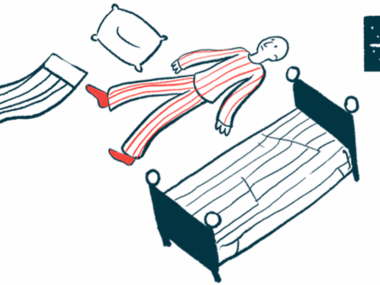Xadago as Add-on Therapy Eases Sleep Disturbances, Pilot Study Finds
Written by |

Three months of Xadago (safinamide) as an add-on therapy lessened symptoms of rapid eye movement sleep behavior disorder (RBD) in people with Parkinson’s disease, a pilot study in patients reported.
The study, “Effects of safinamide on REM sleep behavior disorder in Parkinson disease: A randomized, longitudinal, cross-over pilot study,” was published in the Journal of Clinical Neuroscience.
Parkinson’s presents with a variety of motor and non-motor symptoms, including such sleep disturbances as RBD.
During RBD, a person physically reacts to events happening in a dream. Reactions often consist of abrupt twitches or jerks, but can include violent thrashing. RBD is considered a possible early symptom of neurodegenerative disorders involving toxic accumulations of certain proteins, such as Parkinson’s and Alzheimer’s.
In the case of Parkinson’s, misshapen alpha-synuclein protein clumps together inside of nerves, damaging and eventually killing these cells.
In normal rapid eye movement (REM) sleep, the chemical messengers glutamate and dopamine are involved in preventing nerve signals from triggering muscle movements. In the case of Parkinson’s, however, too much glutamate can be released, while too little dopamine is available to maintain healthy nerve activity.
Xadago, an approved therapy for Parkinson’s motor symptoms, works to prevent the excessive release of glutamate and to extend the length of time that dopamine is available by blocking the enzyme monoamine oxidase B, which breaks dopamine down.
This mechanism of action led a group of scientists affiliated with Pugliese Ciaccio Hospital, in Catanzaro, Italy, to investigate the medication’s potential in easing RBD.
They recruited 30 adults with Parkinson’s (18 men and 12 women) for a six-month study of Xadago’s effects on RBD symptoms. Investigators randomized participants into two groups — one for three months would receive their normal Parkinson’s therapies plus Xadago, and the other their medications without Xadago. Then group assignments would switch for another three months.
Treatment with Xadago broadly correlated with reduced RDB symptoms and better overall sleep, as measured by average UPDRS-II and III scores (standard measures of disability, according to activities of daily living and motor skills, respectively), the Parkinson’s Disease Sleep Scale (PDSS-2), and the sleep behavior disorder questionnaire-Hong Kong (RBDQ-HK), which, with the PDSS-2, evaluates the frequency and severity of disturbed sleep.
In all, 22 of these 30 people (73.3%) reported “clear improvement” in their symptoms while taking Xadago, while eight reported “mild improvements” in RBD symptoms, despite observing no change in their daytime symptoms. Sixteen patients reported being free of any RBD symptoms by the end of the treatment period.
Average UPDRS-II and III scores decreased across all groups, indicating lesser disability. Similarly, both motor symptoms and nighttime sleep disturbances eased, according to average changes in PDSS-2 scores.
Study participants also reported fewer disturbed sleep behaviors, such as ‘‘dream-related movements” or falling out of bed, as seen in responses to the RBDQ-HK.
“The findings of our study suggest that the efficacy on RBD-symptoms in [Parkinson’s] patients could be mediated by the [Xadago] action on the glutamatergic pathway,” the researchers concluded.
“Further research using a large sample size and considering various additional influencing factors (as [Xadago] in different dosage) should be conducted to confirm the results reported herein.”






